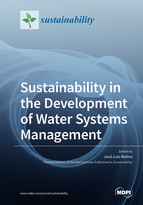Sustainability in the Development of Water Systems Management
A special issue of Sustainability (ISSN 2071-1050). This special issue belongs to the section "Resources and Sustainable Utilization".
Deadline for manuscript submissions: closed (31 July 2020) | Viewed by 35316
Special Issue Editor
Interests: sustainability; water resources management; rivers; civil engineering; environmental science; hydrology; environmental engineering; hydraulics; groundwater; surface hydrology; water resources; climatology; hydrogeology; drought; water science; bayesian analysis; uncertainty; decision support systems
Special Issues, Collections and Topics in MDPI journals
Special Issue Information
Dear Colleagues,
The concept of sustainability has been intensively used in the last few decades since Brundtland´s report was published in 1987. This concept, due to its transversal, horizontal, and interdisciplinary nature, can be used in many disciplines, scenarios, spatiotemporal dimensions, and different circumstances. The intensive development of analytical techniques and tools of the last years based on disciplines such as artificial intelligence, machine learning, data mining, information theory, internet of things, among others, means that we are in a very good condition to analyze the sustainability of water systems from a multiperspective way. Water systems management requires the most advanced approaches and tools for rigorously addressing all the dimensions involved in the sustainability of its development. Consequently, the aspects for addressing the sustainability of water systems management may comprise physical (natural), chemical, socioeconomic, legal, institutional, infrastructure (engineering), political, and cultural processes, among others. This Special Issue welcomes general and specific contributions that address the sustainability of water systems management considering its development. Special attention will be given to those contributions that consider trade-offs and/or integration between some of the aspects/disciplines that drive the sustainability of water systems in the context of their development and management.
Dr. José-Luis Molina
Guest Editor
Manuscript Submission Information
Manuscripts should be submitted online at www.mdpi.com by registering and logging in to this website. Once you are registered, click here to go to the submission form. Manuscripts can be submitted until the deadline. All submissions that pass pre-check are peer-reviewed. Accepted papers will be published continuously in the journal (as soon as accepted) and will be listed together on the special issue website. Research articles, review articles as well as short communications are invited. For planned papers, a title and short abstract (about 100 words) can be sent to the Editorial Office for announcement on this website.
Submitted manuscripts should not have been published previously, nor be under consideration for publication elsewhere (except conference proceedings papers). All manuscripts are thoroughly refereed through a single-blind peer-review process. A guide for authors and other relevant information for submission of manuscripts is available on the Instructions for Authors page. Sustainability is an international peer-reviewed open access semimonthly journal published by MDPI.
Please visit the Instructions for Authors page before submitting a manuscript. The Article Processing Charge (APC) for publication in this open access journal is 2400 CHF (Swiss Francs). Submitted papers should be well formatted and use good English. Authors may use MDPI's English editing service prior to publication or during author revisions.
Keywords
- sustainability
- integration
- water systems
- trade-off
- analytical tools
- development
- water management






